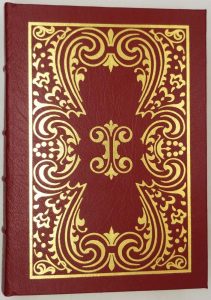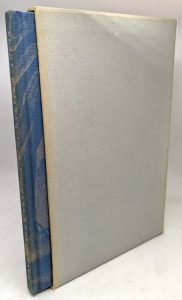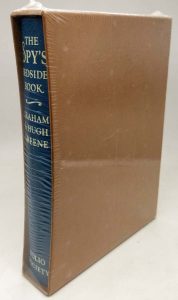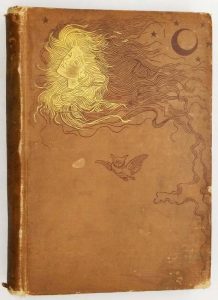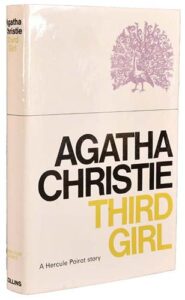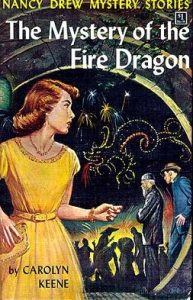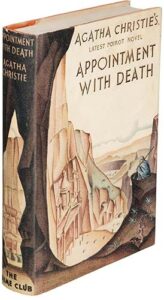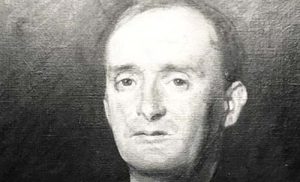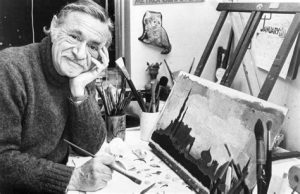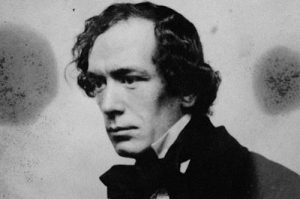The Road to Oz: In Which Is Related How Dorothy Gale of Kansas, The Shaggy Man, Button Bright, and Polychrome the Rainbow’s Daughter Met on an Enchanted Road and Followed it All the Way to the Marvelous Land of Oz. is the fifth of L. Frank Baum’s Land of Oz books. It was originally published on July 10, 1909 and documents the adventures of Dorothy Gale’s fourth visit to the Land of Oz.
This is the only Oz book to be printed on colored pages instead of with colored pictures. The colored pages represent the signature colors of the various countries of Oz that Dorothy and her companions travel through on their way to the Emerald City.
The Tin Woodman’s garden features images of Dorothy and Toto, representing them as they first arrived in Oz. The illustrator, John R. Neill, apparently takes this description literally, by causing the statues to resemble the illustrations made by his predecessor, W.W. Denslow. This is in contrast to the “real” Dorothy, who is drawn here much as she is drawn in all of the Oz books illustrated by Neill. It is implied that she is amused by the differences present; she has apparently lost weight, as well as changed her attire.
Summary
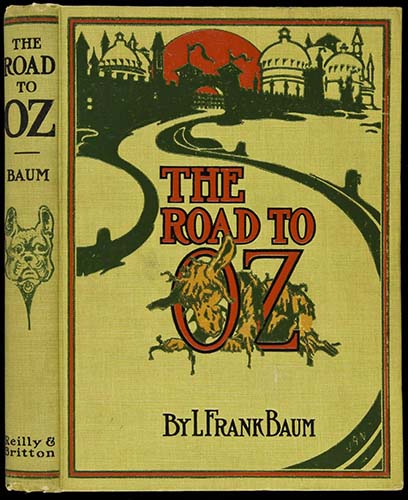
While Dorothy Gale is at home in Kansas one day, she and her pet dog Toto meet the Shaggy Man who comes walking past the Gale farm. He is a friendly, yet slightly senile hobo with an optimistic, care free mentality. He politely asks Dorothy for directions to Butterfield, which is the nearest town on the prairie. The girl agrees to show him the way, bringing her dog with her. Further on, the road splits into seven paths. They take the seventh one and soon find themselves lost in what appears to be another dimension. The trio meets Button-Bright, a cute and wealthy little boy in a sailor’s outfit who is always getting lost. Later, the companions encounter Polychrome, the beautiful and ethereal Daughter of the Rainbow who is stranded on earth. Polychrome explains that she accidentally fell off her father’s bow while dancing on it. The bow ascended into the atmosphere and back into the clouds before she was able to climb her way back on it, thus being left behind.
Dorothy, Toto, the Shaggy Man, Button-Bright, and Polychrome eventually come to the peculiar town of Foxville, where anthropomorphic foxes live. With prompting from King Dox of Foxville, Dorothy deduces that she and Toto are obviously on another “fairy adventure” that will ultimately lead them to the magical Land of Oz, just in time for Princess Ozma’s royal birthday party (which is now acknowledged as August 21 by Oz fans, even though the book only refers to the 21st of the month, Dorothy having mentioned that the current month is August in another passage). The king takes a particular liking to Button Bright, whom he considers astute and clever due to his tabula rasa-like mind. Believing that the human face does not suit one so clever, Dox gives him a fox’s head which he is unable to remove. A similar event subsequently happens to the Shaggy Man, when King Kik-a-Bray of Dunkiton confers a donkey’s head upon him — also in reward for cleverness, even though it is implied that Foxville and Dunkiton exist at odds with one another. Though both of them ask Dorothy to procure them invitations to Princess Ozma’s birthday party.
After meeting the Musicker, who produces music from his breath, and fighting off the Scoodlers, who fight by removing their own heads and throwing them at the travelers, Dorothy and her companions reach the edge of the fatal Deadly Desert completely surrounding Oz. There, the Shaggy Man’s friend Johnny Dooit builds a “sand-boat” by which they may cross. This is necessary, because physical contact with the desert’s sands, as of this book and Ozma of Oz (1907), will turn the travelers to dust.
Upon reaching Oz, Dorothy and her companions are warmly welcomed by the mechanical man Tik-Tok and Billina the Yellow Hen. They proceed in company to come in their travels to the Truth Pond where Button Bright and the Shaggy Man regain their true heads by bathing in its waters. They meet the Tin Woodman, the Scarecrow, and Jack Pumpkinhead who journey with them to the imperial capital called Emerald City for Ozma’s grand birthday bash. Dorothy meets up with Ozma as her chariot is pulled in by the Cowardly Lion and the Hungry Tiger.
As preparations for Ozma’s birthday party are made, the guests include Dorothy, Scarecrow, Tin Woodman, Cowardly Lion, the Wizard of Oz, Jack Pumpkinhead, the Sawhorse, Tik-Tok, Billina, Jellia Jamb, Woggle-Bug, Hungry Tiger, the Good Witch of the North, Shaggy Man, Button-Bright, Polychrome, and characters from all over Nonestica (such as Santa Claus, a band of Ryls, and a bunch of Knooks from the Forest of Burzee, Queen Zixi of Ix, the Queen of Merryland, four wooden soldiers, and the Candy Man from Merryland, the Braided Man from Boboland’s Pyramid Mountain, the Queen of Ev, King Evoldo, and his nine siblings from the Land of Ev, King Bud and Princess Fluff from Noland, and John Dough, Chick the Cherub, and Para Bruin the Rubber Bear from Hiland and Loland) as well as invitations to King Dox, King Kik-a-Bray, and Johnny Dooit. Though Princess Ozma couldn’t procure an invitation to the Musicker due to a chance that his uncontrollable vocal tic might arouse violence against him. The Shaggy Man receives permission to stay in Oz permanently. He is given, in addition to this, a new suit of clothes having bobtails in place of his former costume’s ragged edges, so that he may retain his name and identity.
After everyone has presented their gifts and feasted at a lavish banquet in Ozma’s honor, the Wizard of Oz demonstrates a method of using bubbles as transportation by which to send everyone home. Polychrome is finally found by her rainbow family and she is magically lifted into the sky when she climbs back onto her bow. Button-Bright goes home with Santa Claus in a soap bubble with the Sawhorse loaned to Santa Claus. Dorothy and Toto are finally wished back home to Kansas again by Ozma’s use of the Magic Belt.
Frank Baum – The Road to Oz | First Edition Identification Guide
Please refer to the gallery for detailed images of binding(s) and dust jackets.
| Year | Title | Publisher | First edition/printing identification points |
|---|---|---|---|
| 1909 | The Road to Oz | Reilly & Britton Co., [1909] | As with other Oz books already described, first-state copies of the text sheets of The Road to Oz have been found in later binding variants. The description here indicates the usual arrangement of the color-tinted text sheets. Several copies, however, have been discovered that have different arrangements of the colors. First edition. Illustrated by John R. Neill, 261 pages. Four major states: - 1 - Textual points: There are two pages of advertisements at the end of the book: page [263] lists Baum books published under the pseudonym “Laura Bancroft," and page [264] lists four other Baum titles: The Land of Oz, Ozma of Oz, Dorothy and the Wizard of [sic] Oz, and John Dough and the Cherub. There are no color plates. The gatherings are printed on variously tinted stock: off- white (pages [l]-32), lavender (33-64), gray (65-96), light blue (97-128), salmon (129-160), tan (161-192), light green (193-256), tan (257-[264]). The first copies off the press have perfect type in the words “Toto on”, page 34, line 4, and in the numeral “121” on page 121; and the numeral and caption are present beneath the illustration on page 129. Later copies may show type damage on either or both pages 34 and 121, and in still later copies the caption and numeral are dropped from page 129. Inserted pictorial endpapers printed in black and red on tan stock of the same quality as the text stock. Binding: light-green, smooth fine-grained cloth, stamped in black, dark green, tan, and red. (Some copies have been reported in a coarse-weave cloth sometimes described as buckram.) The back cover has silhouette portraits of Dorothy and Ozma within a sunburst effect. The spine is stamped in black, dark green, and red, with an illustration of Toto in dark green. The publisher’s name at the foot of the spine reads: “Reilly & | Britton”. SECONDARY BINDING: Some copies have the spine imprint reset in large and small capitals: “Reilly & | Britton". Dust jacket: issued in a full-color dust jacket. The front panel has an illustration that differs from the front cover design, printed in full-color with a metallic gold background. The back panel reproduces the advertisement that appears on page [264]. The front and rear flaps are blank. Size of leaf: 9 by 6 5/8 inches. Thickness of volume: 11/16 inches. NOTE: Because there is insufficient physical evidence to classify as separate printings minor variations among copies of The Road to Oz printed on color-tinted stock, we have grouped all such copies as part of state 1. We offer below descriptions of a number of variant copies that differ from the normal arrangement of color-tinted text sheets. The variants are listed roughly in the sequence of progressive type damage. The reader should remember that so long as the book was in continuous production and was assembled in the bindery as orders came from the publisher to bind up a new group of copies, it was always possible for sheets of different vintages to be assembled to produce mixed copies. A) Apparently part of the earliest copies of state 1, but it differs in having pages 33-64 on off-white rather than lavender stock. Earlier binding.B) Apparently part of the earliest copies of state 1, but it differs in having pages 113-128 on light green rather than light-blue stock. Secondary binding. C) The same as later copies of state 1, with plate wear at all the places noted. It differs in having the terminal gathering printed on salmon stock rather than tan. Earlier binding case. D) The same as later copies of state 1, with plate wear at all the places noted. It differs in having the tinted text sheets arranged in the following pattern: off-white (pages [ 1 ]-16), gray (17-32), lavender (33-64), gray (65-96), light blue (97-128), salmon (129-160), tan (161-192), salmon (193-208), light green (209-256), tan (257-[264]). The endpapers are of highly calendered stock. Secondary binding. E) The same as later copies of state 1, with plate wear at all places noted, except that page 34, line 4 has “Toto on” in perfect type. (It has been suggested that the type has been reset at that place; it is unbroken in later printings.) As with variant C, it has the terminal gathering printed on salmon stock rather than tan. Earlier binding. F) The same as later copies of state 1, with plate wear at all places noted, except that page 34, line 4 has “Toto on” in perfect type. It differs in having the terminal gathering printed on gray stock rather than tan. Secondary binding. Later printings - 2 - Textual points: Same as variants E and F described above (with “Toto on”, page 34, in perfect type) except that there is a publisher’s advertisement on the verso of the ownership page listing Oz titles through Rinkitink in Oz (1916); there are no advertisements at the end of the book. The entire book is printed on white stock and the endpapers are blank. Binding: Similar to the earlier covers except that the back cover is blank. The publisher’s name on the spine reads: “Reilly | & Britton”. - 3 -Textual points: Same as #2 except that the advertisement lists titles through The Lost Princess of Oz (1917). Binding: Same as #2. Binding: Same as # s 2 and 3 except that the design is stamped on off-white (or light-tan) cloth. SECONDARY BINDING: Copies of #4 sheets, including the Reilly & Britton title page, have been seen in gray-green cloth with the spine imprint reading “Reilly | & Lee”. One copy of this variant has been noted in bright emerald-green cloth. One green-bound copy has been reported without any advertisements. The back cover is blank, and the spine imprint reads: “Reilly & | Britton”. When this book was printed is not known. That it does not have advertisements argues for a date of between 1910-1915, but its thickness (11/2 inches) may indicate that it was published at a later date. Subsequent printings of The Road to Oz carry the Reilly & Lee imprint on the title page and have pictorial paper labels on the front cover. This label design is identical with the front panel of the original dust jacket except that the background of the design is printed in blue or, later, in yellow rather than metallic gold. Copies have been seen with advertisements listing titles through The Magic of Oz(1919), Glinda of Oz (1920), and The Hungry Tiger of Oz (1926). Other copies, probably later, have no publisher’s advertisements. |
Frank Baum – The Road to Oz | First Edition Dust Jacket Identification
First edition binding(s) and various Dust Jacket printings identification.
Reference:
- Wikipedia
- Bibliographia Oziana – Haff, Greeme, Martin. 2002
